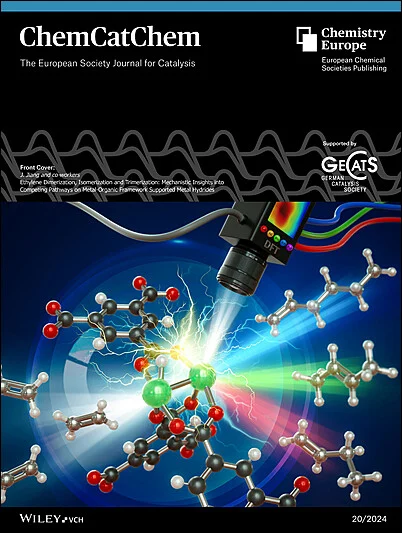Effects of Acid Sites on Thin MCM‐22 Zeolite Catalysts and Their Catalytic Applications for Acetylene Aromatization
IF 3.8
3区 化学
Q2 CHEMISTRY, PHYSICAL
引用次数: 0
Abstract
Two types of thin zeolite MCM‐22 catalysts were prepared by using a carbon sphere template. By different calcination methods, a hollow sphere‐type MCM‐22 (HS‐MCM‐22) and a nanosheet‐type MCM‐22 (NS‐MCM‐22) were synthesized. Those catalysts were tested and evaluated for acetylene aromatization to see the effects of thin structures. The two types of thin catalysts were found to have higher amount of acid sites than that of the conventional MCM‐22 catalyst. It was found that the extremely short diffusion length not only enhanced the aromatic yield, but also suppressed the formation of graphitic coke. Notably, the diffusion length of NS‐MCM‐22 was found to be at least 15 times shorter than that of conventional MCM‐22, leading to an 11 % and 18 % increase in benzene yield, respectively. The thin structure seemed to help the produced aromatics efficiently desorb before they further converted into carbon precursors and coke. The carbon species in the spent thin catalysts were found less graphitic than that of the conventional MCM‐22 catalyst. Because of this, the thin MCM‐22 catalysts were believed to show higher coke removal capability. Especially, the coke removal rate of NS‐MCM‐22 was estimated over 90% despite the severe carbon deposition during reaction.酸性位点对薄型 MCM-22 沸石催化剂的影响及其在乙炔芳香化中的催化应用
利用碳球模板制备了两种薄沸石 MCM-22 催化剂。通过不同的煅烧方法,合成了空心球型 MCM-22(HS-MCM-22)和纳米片型 MCM-22(NS-MCM-22)。对这些催化剂进行了乙炔芳构化测试和评估,以了解薄结构的效果。结果发现,与传统的 MCM-22 催化剂相比,这两种薄型催化剂具有更多的酸位点。研究发现,极短的扩散长度不仅提高了芳烃产率,还抑制了石墨焦的形成。值得注意的是,NS-MCM-22 的扩散长度至少是传统 MCM-22 的 15 倍,从而使苯产率分别提高了 11% 和 18%。薄型结构似乎有助于生成的芳烃在进一步转化为碳前体和焦炭之前有效地解吸。与传统的 MCM-22 催化剂相比,废薄催化剂中的碳种类石墨化程度较低。因此,薄型 MCM-22 催化剂被认为具有更高的除焦能力。特别是,尽管在反应过程中碳沉积严重,但 NS-MCM-22 的焦炭去除率估计超过 90%。
本文章由计算机程序翻译,如有差异,请以英文原文为准。
求助全文
约1分钟内获得全文
求助全文
来源期刊

ChemCatChem
化学-物理化学
CiteScore
8.10
自引率
4.40%
发文量
511
审稿时长
1.3 months
期刊介绍:
With an impact factor of 4.495 (2018), ChemCatChem is one of the premier journals in the field of catalysis. The journal provides primary research papers and critical secondary information on heterogeneous, homogeneous and bio- and nanocatalysis. The journal is well placed to strengthen cross-communication within between these communities. Its authors and readers come from academia, the chemical industry, and government laboratories across the world. It is published on behalf of Chemistry Europe, an association of 16 European chemical societies, and is supported by the German Catalysis Society.
 求助内容:
求助内容: 应助结果提醒方式:
应助结果提醒方式:


